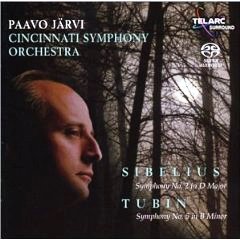
|
(first published in The Cincinnati Post Aug. 27, 2002)
Sibelius' Symphony No. 5 was Estonian born Paavo Järvi's calling card when he first conducted the Cincinnati Symphony in February, 1999. That indelible impression was enough to make him front runner in the search for a music director to succeed Jesús-López-Cobos.
Named to the post in January 2000, Järvi reaffirms that mastery with this new release from Telarc, his second with the CSO (Berlioz' "Symphonie fantastique'' was the first). It is so painstakingly crafted and so true to the spirit of the Finnish composer that one is tempted to call it definitive.
That takes some doing, because the catalogue is full of Sibelius Seconds (19 in the 2001 Schwann Opus, with many more available online). They range from various shades of romantic to the more classically refined. Järvi's empathy for the work -- perhaps it's his Finno-Ugric blood (Estonians and Finns are related) -- is matched by Telarc's sublime sound and the marvelous playing of the CSO.
Telarc never takes a back seat in sound quality, and every detail of the performance can be heard in just the right proportion. This should make it a treat for audiophiles, as Telarc is releasing it in both CD and its new multi-channel Super Audio Compact Disc format.
Of course, it takes the right conductor to lay out the sonic road map, and Järvi knows Sibelius' often-craggy terrain well. He hears -- and draws from the players -- nuances and configurations that are smudged in more superficial accounts.
Järvi's reading is persuasively Nordic, with the emphasis on gravity and deep feeling. It may be compared with his father Neeme Järvi's with the Gothenburg Symphony (Sweden) and Finnish conductor Paavo Berglund's with the Helsinki Philharmonic. Yet Järvi's feelings seem more precisely expressed. You want "lugubrious" in the second movement? (Sibelius' own marking). Check out the opening bassoon solo. There's a surprising sadness in the Trio section of the scherzo too, with its keening oboe solo. By contrast, the flute that tops off the roiling second section of the finale is ineffably sweet.
The triumphant finale has a for-the-ages sheen. The all-important brasses play with astonishing clarity, and timpanist Eugene Espino adds grandeur and depth to the closing bars by rolling out low D's on his 36-inch kettledrum.
Paired with the Sibelius is the Symphony No. 5 by Estonian composer Eduard Tubin (1905-82). Completed in 1946 in Sweden, where Tubin and thousands of his countrymen took refuge as the Soviet Union completed its takeover of Estonia in the last days of World War II, it's a powerful work that, like its composer, should be better known. This is the first American recording (Neeme Järvi made the world premiere recording for the Swedish label Bis in 1985).
Tubin was influenced by Bartok, Ravel and the Russian composers Scriabin and Stravinsky. Estonian folk music plays an important part in his works -- he wrote 10 symphonies -- and they tend to reflect his life experiences and those of his country (nine percent of the population of Estonia was deported to Siberia in the 1940s).
The dramatic, three-movement symphony is filled with turbulence and pathos -- the events of war, the composer said. The first and last movements end with a pair of timpani ""battling it out,'' while the tragic slow movement interweaves a pair of Estonian folk songs. Järvi extracts every drop of anger and irony -- the march-like finale recalls Shostakovich -- and it ends with what a reviewer at the world premiere in Stockholm in 1947 called a view of The Promised Land.
With this latest release, the CSO will be expanding its global reach. In July, the orchestra was recognized by Ohio Gov. Robert Taft with his Excellence in Exporting Award. Of the 8.7 million CSO recording units sold since 1980, 4 million, or 46 percent, have been sold in foreign countries. Järvi will sign copies of the new CD and the earlier Berlioz disc at Joseph-Beth Booksellers in Norwood from 3 to 4 p.m. Sept. 22.